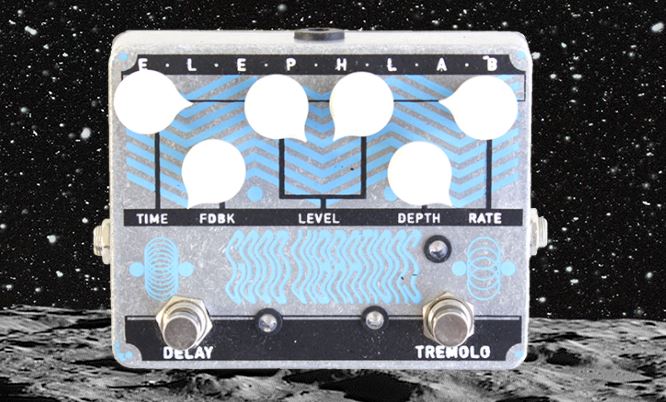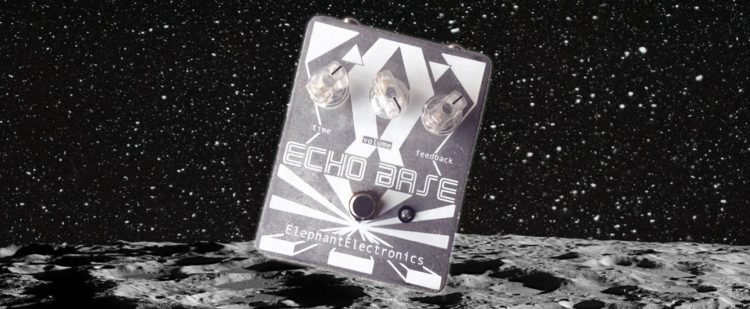This post may contain affiliate links
Elephlab is an effect pedal and synthesizer company based out of Mexico City, Mexico. We had the pleasure of speaking with Alan Rabchinsky, the owner and operator behind the Elephlab business! We actually found Elephlab when they ordered one of our old Pedal Haven coffee mugs (now discontinued – sadly), and we quickly fell in love with their pedals! We are honored to be able to interview Alan at Elephlab, and you should definitely take the time to check out what the company is working on!
Pedal Haven: Most importantly…. How is that Pedal Haven mug treating you? You own the only one in existence!
Oh! I love every sip of coffee I get from it. Adds a sweet detail to my mornings, wakes up my curiosity, and makes me wonder about that classic triangle big muff circuit. Since then a strange force has been with me. Keep thinking I should do the schematic to breadboard process, based entirely on that mug.
We are glad that our mug can bring such inspiration to your mornings!
Alright, let’s dive in!
PH: Let’s start by having you tell us a little bit about yourself & the company? What is your role at Elephlab? Is Elephlab a one-person operation? What is it like building pedals out of Mexico City?
Hello! My name is Alan Rabchinsky. I’m an audio engineer graduate, and the person behind Elephlab. I’m a drummer who started playing in bands, then later got into recording, and more recently I have been into building pedals and synthesizers. So the company is a way to bring those ideas (or I should say clones) to the world.
It is certainly a one-person operation. I personally do every single step of the entire process. Although I do get occasional help on the assembly and the design of the builds.
Being in Mexico City makes it easier to find some parts (we have electronic retail shops downtown). But at the same time it is tough to get your product out at music stores, and making pedals and builds accessible to the customer – I currently don’t have any dealers, so I’m running the sales myself.
PH: Favorite band?
My favorite band is called, CAN. I also like all krautrock, drone, and avant-garde albums.

PH: How long has Elephlab been building pedals?
It started in 2013 so it has been about four and half years by now.
PH: What inspired you to start Elephlab? What inspired you to start building pedals?
As a musician I felt attracted to sound electronics and building my own devices to create unique sounds, but I didn’t know exactly where to start. I’ve always been curious about how things are made! When I was young, I used to dissemble remote controls just to look at their guts. Afterwards, while doing research on manufacturers and electronic gurus, I discovered Reed Ghazala’s “Circuit Bending” book, and kept learning, but got nowhere.
Later on I collaborated in art installations, and this is where I learned how to solder – among other things. I was interested in effects and I really wanted to build a delay pedal. I found Tonepad´s “Rebote 2.5” project and then I was addicted! I’ve built dozens of them!
Next I got a copy of Craig Anderton “Electronic Projects for Musicians” which was a reliable guide to continue along this path. I also attended many workshops, which helped fill the gaps. Initially the intention was to be a DIY kit and components store, but really it was just me building pedals as a hobby so it kind of developed from there.
Want to start building pedals? Check out our Building DIY Guitar Pedals Guide!
PH: I personally love the Good Vibrations pedal that you have built – That pedal looks amazing! Tell us a bit more about the Good Vibrations! How did that pedal start out? Was a 2-in-1 tremelo+delay pedal your original thought when designing the pedal, or did it start as two separate pedals?
Sure, this is the story behind it. My friend Ian (who is a talented designer and guitarist) and I were casually drinking a beer and shouting out ideas. We wanted to pay homage old-school psych bands by building pedals and naming the pedals after their songs. He then remembered that a lot of old amplifiers used to have tremolo and reverb as built in effects. I thought it would be a good idea to change the reverb for a delay! I looked up for some circuits that may work for this. It is the very first pedal I have put together as a prototype, before actually building a first batch. At first the tremelo was similar to an EHX Pulsar, however for the final product we went with a ROG EA Tremolo. Ian came out with a design, and there we have a product!

It has always been a 2-in-1 pedal, but eventually I will start building them as separate units as requested.
PH: When you think of a new pedal to create – what is your process from start to finish?
This is a tough question. As a pedal manufacturer, I should be designing my own circuits entirely from scratch. However, I am not an electronics engineer myself, so I usually skip the breadboard process. With that being said, when It´s time to create a new pedal I usually head over to the Effects Layouts blog and watch demo videos until I find a project that matches the needs. Dave´s work is truly something great. As far as my process goes – I print my own PCB via silkscreen, then I etch the boards, drill them, populate them, test them, print the design onto the enclosure (also via silkscreen), drill the enclosure, then do what´s called “offboard wiring”. Then I test the pedal , and troubleshoot it if needed. Not everyone knows how big of a process it is to create a boutique effect pedal!
PH: Is there an Elephlab pedal or synth that you are particularly proud of?
Yes, that is the Echo Base. That effect pedal started the whole company. I still work on it to this day. I’m proud that I have built so many of them. It will keep evolving as time goes on.
PH: You recently posted a video for the MFOS Noise Toaster. That looks like an interesting build! Can you tell us about that?
It is no doubt an interesting build, and an introduction to modular synthesizers. It started whe I saw Ray Wilson´s book. The MFOS Noise Toaster took me about two to three months to build, and it required a lot of attention to detail. I gathered all the parts from local shops, printed the panel myself, did the wiring, and (fortunately) it worked! It is an excellent tool for frequency sweeps with lots of wacky modulation options!
PH: What should the world expect from the future of Elephlab? Future plans for pedals, or the company as a whole?
Hopefully we will continue building pedals and keep growing. I am digging into different distortions and will be releasing some – starting with the FOXX Tone Machine. Also I have gotten bitten by the Eurorack bug, so I’m exploring that as well. I also want to start building Yusynth´s VC Oscillator & VC Filter and see how that goes.
At some point I will start designing my own circuits from scratch, and developing exciting stuff like sequencers.
PH: Are there any other pedal builders or companies that you have been watching lately? Anyone you want to shout out?
I am always watching out for other builder’s work. My favorite at the time is Lamp Electric – There is something about him! He is really passionate, and he keeps getting better! Been wanting to get a MNTP Fuzz from Lamp Electric for a while now. Also you got to love Champion Leccy Effects. I consider them both great artists!
We want to thank Alan and Elephlab for taking the time to answer these questions! We are very excited to watch the company grow!

